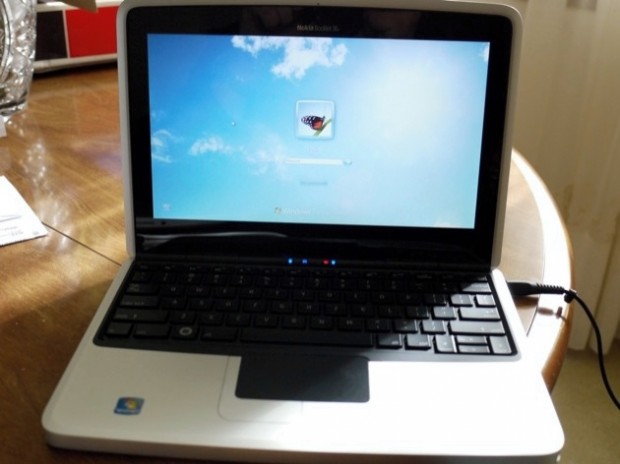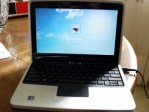
Short Version: When Nokia first announced their Netbook 3G, expectations were mixed. After all, Nokia defined the mobile phone space but they’ve hardly been good at expanding out of the handset market. My take? This is a bit too underpowered and a bit too generic to be a truly great Nokia product but, given the price ($299 with contract) it may be a nice tertiary computer for on-the-go users.
Well, It’s Small
This is one of the smallest netbooks I’ve had the pleasure to carry. It weighs less than three pounds and is about 12 inches long. It is quite thin and the 10-inch, 1280×720 pixel screen is covered in glossy glass. The keyboard us tucked tight against the screen giving you about four inches of palm space on the wrist-rest/trackpad portion versus the same space for all the keys.
The model we tested had a 120GB hard drive, 1GB of RAM, and a Intel Atom Z530 Processor running at 1.6 GHz. I has an SD card slot, SIM slot, and supports WiFi and Bluetooth. It includes an HDMI out port and a 1.3 megapixel camera. It is made of lightweight aluminum and has a definite MacBook feel except for the rounded front and top.
It also includes integrated A-GPS and GPS along with Ovi Maps, Nokia’s mapping software. It runs Windows 7 Starter edition. More on that shortly.
So what is this thing?
If your first question about the Booklet 3G is “Where can I buy it?” you may be slightly surprised. The Booklet is selling at Best Buy for $299.99 with two year Data Connect contract which ensures you’ll have 3G Internet in areas, presumably, where AT&T 3G is supported. It costs $599.99 without contract.
What you’re essentially buying here, then, is one of the first carrier subsidized netbooks. The question, here, then is whether to buy one of AT&Ts other mobile offerings for about $300 (*cough* iPhone *cough*) or a laptop with a keyboard and Windows 7. Call me old fashioned, but my money is still on a 3G phone when it comes to anything with a screen and a Mi-Fi dongle when it comes to portable networking. To lock yourself into one laptop for two years, especially one so underpowered, is, unfortunately, folly.
The Booklet scored 2.2 on the Windows Experience Index which puts it in the same classification as that old Dell in the closet or a potato ricer. It got 774 on GeekBench, a fairly lackadaisical score considering the year old MSI Wind scored 837.
The question, then, is whether this thing is a really big cellphone or a small, underpowered laptop. Given that you can’t make calls on it, I’m aiming for the latter. The buy-in required to own it is also a bit onerous.
Bad News: It’s Laggy
The biggest problem I found was lag. Closing a window takes a few seconds while browsing the web is an exercise in frustration. Because the processor can’t render pages fast enough you find yourself waiting quite a bit. YouTube videos took quite a while to load while other Flash load times were interminable. Netbooks were designed for web use and this is one slow web device.
The trackpad buttons are also a bit hard to press, which adds insult to laggy injury.
Good News: It literally lasts for hours
At first couldn’t test the battery on this thing because I didn’t have enough time to sit around and watch it. This laptop literally keeps going and going. It’s rated for 12 hours and I saw about 10 hours in movie playback. That’s great.
So who is it good for?
I feel that the Booklet is an odd chimera by any standard. It’s a netbook by one of the most famous cellphone makers and it’s subsidized like a cellphone but is not worth its unsubsidized price. In a nutshell, it doesn’t make a lot of sense.
Perhaps there is a market out there for subsidized netbooks. Perhaps a fleet of these things given out to a sales force in lieu of BlackBerrys might make sense. However, I’d be hard-pressed to find a mobile professional who wants to skimp on processor power to get WWAN capabilities.
I think devices like the Booklet are filling a hole in the market that will soon be overtaken by standalone, wireless WWAN-to-WiFi devices or, dare I say it, WiMax dongles. Until then, devices like this will fill that void although I feel that the end user will be underserved with these devices.
However, Nokia has proven it can make and build a nice netback, all things being equal, for the low end of the market. Is it a dream device? No, but it’s a strong showing and if they can get the unsubsidized price down to the subsidized price I’d be willing to recommend it to the general user.
